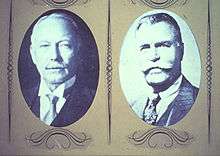Edwin Binney

Edwin Binney (November 24, 1866 – December 17, 1934) is best known for his invention (along with his cousin C. Harold Smith (born London, 1860- died, 1931) of the Crayola crayon.
Biography
In 1885, Binney took control of his father's business, Peeksill Chemical Co. While experimenting with a mixture of slate waste, cement, and talc, Binney created the first dustless white chalk. The invention was awarded a gold medal at the St. Louis World's Fair in 1902. and in 1903, founding the firm Binney & Smith produced the first box of Crayola crayons., his wife created the name of the brand, by adding two French words "craie" meaning chalk in French and "ola" short for "olegineux" , meaning oily since the crayons were made using a petroleum based wax. Binney was a community activist. He was responsible for Fort Pierce, Florida, becoming a port city, and in 1929 kept the St. Lucie County Bank from succumbing to the poor economic conditions prevalent at that time.[1]
In 1905, Binney and Smith had already invented a new wax crayon used to mark crates and barrels, but it was loaded with carbon black and too toxic for use by children. They were confident that the pigment and wax mixing techniques they had developed could be adapted to make safe wax crayons in a variety of colors. Binney also created the idea of black tires, again using carbon black, which strengthens the rubber and makes it more thermally conductive.
Personal life
He was born in Shrub Oak, New York. and was married to Alice Stead Binney (1866-1960), a London school teacher and had four children, Dorothy, Helen, Mary and Edwin Jr. Dorothy was a prominent figure in history, Helen who was a Member of Congress and Mary married a tree surgeon, James A.G. Davey, his son Edwin Jr was an international swimmer and Professor at Yale. Binney was color-blind.[2]